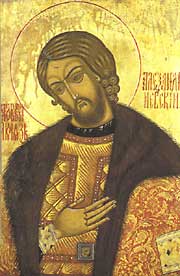*Image Credit: Wikimedia Commons Frustrated with the slow eastward advance of the Teutonic Order, Alexander Nevsky stood on the shores of Lake Peipus determined to halt the German knights’ encroachment on April 5, 1242. Marching his army out onto the frozen water, the 20-year-old Nevsky scored a major victory at the Battle of the Ice — one that prevented the Germans from entering Russia, hardening the dividing line between the Roman Catholic and Eastern Orthodox Churches. In 1193, Pope Celestine III declared the Northern Crusades, encouraging the Holy Roman Empire and Kingdom of Sweden to advance east into pagan-occupied territory. What Celestine had done, in effect, was give official credence to forced conversion that began almost 50 years before. From then on, the Church would support any knights attempting to spread Rome’s influence farther to the north and east. The Swedes did much to solidify control of Scandinavia, leaving the Teutonic Knights — a German Order in the northern Holy Roman Empire — to grab hold of modern Latvia, Estonia and Lithuania. From 1198, they did just that, methodically working through Baltic tribes that formed a de facto pagan buffer between the Roman Catholic and Eastern Orthodox branches of the Christian faith. Within a decade, much of the region was under Teutonic control. As the Germans moved into Estonia in 1208, however, resistance became more fierce: the Estonians would not take the invasion lightly. Backed by Russian soldiers from the neighboring Novgorod Republic, the pagan natives managed to force the Teutonic Order into a 30-year slog to acquire the territory. Finally, at the Battle of Saule in 1236, the Germans vanquished the Estonians, expanding the Holy Roman Empire to Lake Peipus. On the other side of the water, the Novgorods realized they would soon be under attack from several directions owing to Celestine’s war. By 1240, when the Swedes swept southward from Scandinavia, it was clear the Catholic armies intended to switch from a war against non-believers to a conflict with their Eastern Orthodox Christian brothers. Mounting a defense along the banks of the Neva River, the teenaged Prince of Novgorod Alexander Jaroslavich convinced his soldiers to seize the momentum. Employing some of his best fighters on the wings of his line, he ordered a surprise attack on the Swedish flanks. With the edges faltering, the troops in the center surrounding Birger Magnusson — the Swedish duke in command — fell back, leaving the leader’s tent exposed. The Novgorods quickly captured Magnusson, securing victory at the Battle of Neva. As a demonstration of respect for this achievement, people dropped “Jaroslavich” from the prince’s name and began calling him Alexander Nevsky. Even with this victory, Novgorod was still in serious trouble. Mongol warriors threatened in the southeast and the Teutonic Order, sensing an opportunity, launched an assault on Pskov late in 1240. Alexander, understandably upset the Germans were 125 miles to the southwest of the capital conquering cities left and right, pushed back the following year. Month after month, in battle after battle, Alexander reclaimed Novgorod lands, finally liberating Pskov in March 1242 and pushing the German knights back into Estonia. Content with the results, he turned toward home only to discover Herman, the Bishop of bordering Dorpat, in pursuit with a well-equipped army and gaining rapidly. Driving his men across the narrowest point of icy Lake Peipus, Alexander reached the eastern shore and turned his soldiers around to organize a defense. With his infantry in the center and horsemen on the flanks, he waited for Hermann and the Teutonic Knights to arrive. On April 5, 1242, the slightly smaller Crusader force lined up on the western shore and lurched toward the Novgorods. The slick footing undermined the Teutonic advantage — chiefly better-trained knights with top-notch weapons — allowing Alexander to call for volley after volley from his archers. Pleased by the disruption of Hermann’s attack, the Novgorod prince led his infantry onto the ice, pummeling the German center while his cavalry encircled the opposition. Before long, the Battle of the Ice devolved into a vicious hand-to-hand fight, with pools of blood contrasting brightly against the grey-white crust of Lake Peipus. The Crusaders, seeing the threat of being surrounded, scrambled back to their starting point having lost as many as 400 men. Though one of the smaller conflicts in the Northern Crusades, the battle served as the last real attempt by Western armies to conquer the Russians for centuries. Spurred by Alexander’s canonization as a saint in the Eastern Orthodox tradition — not to mention heavy propaganda during World War II — the Battle of the Ice served as inspiration to Soviet soldiers 700 years later when the Nazis launched Operation Barbarossa against Russia in 1941. Also On This Day: 1722 – Easter Island is discovered by Dutch explorer Jacob Roggeveen 1818 – Chilean revolutionaries win the Battle of Maipu, a major victory against the Spanish 1930 – Mahatma Gandhi ends the Salt Satyagraha after a 241-mile march to Dandi 1951 – Julius and Ethel Rosenberg receive the death penalty for espionage against the United States 1998 – The Akashi-Kaikyo Bridge, the longest suspension bridge in the world, opens in Japan
April 5 1242 – Alexander Nevsky Defeats the Teutonic Knights at the Battle of the Ice
*Image Credit: Wikimedia Commons Frustrated with the slow eastward advance of the Teutonic Order, Alexander Nevsky stood on the shores of Lake Peipus determined to halt the German knights’ encroachment…
471
